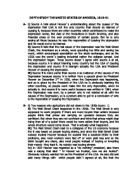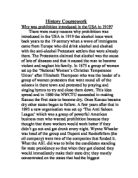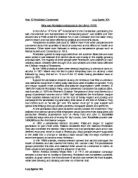Source D also pictures a saloon, but it is the outside with two children looking hopefully in. This infers that their father is in there and using the money needed for their “shoes and stockings”. This would be very effective to women as they would see that the men are wasting their wages on alcohol instead of the basic needs of a child. The picture of the little girl and boy stirs up emotion in people as they look so vulnerable and exposed. The little boy pulling the girls arm is also very evocative and the message underneath is obviously the answer to the question he asked. It is slightly difficult to be able to see what the girl is looking like but she looks like she is looking slightly angry, because this saloon has caused their father to use the money on alcohol. The clothes they are wearing are not of good quality so they are obviously poor or near there. This shows the evils of the father and the salon taking the money to give them new clothes and good. Also the statement below shows that the children know what is going on and they know the consequences of the father’s actions. The children are not inside the saloon possibly because the father does not want them to see that he is wasting the money on this instead of on the children-his family. Also the saloon was seen as a corruptive place and children would not have gone in there.
In conclusion, both the posters are for Prohibition and use devices to get the people to vote for Prohibition. They show that the men cannot do anything but go there and waste their money on themselves rather than their wives and children. A bad image is given of the saloon and of the men who go there.
(c) The two sources are from two different periods of time. One is set at the start of Prohibition whereas the other is set after Prohibition. This will give difference in reliability as evidence of Prohibition.
Source E was written by John D. Rockefeller, who was a wealthy industrialist who would have been for Prohibition as many industrialists believed that alcohol made their workers inefficient. Source E is reliable as it shows hoe many promoters of Prohibition changed their minds during the end of Prohibition. “crime has increased to a level not seen before”. A woman, Pauline Sabin, who may have been a supporter of Prohibition because of her sex, was also against it as the crime rate increased, “Prohibition has led to more violation of and contempt for the law”. This shows Source E to be reliable as there is another source that puts the same point forward. Source H can show that “a vast army of lawbreakers” certainly did come as there was a massive increase in the amount of drunks during the period of 1920 to 1925. The amount of drunk drivers also increased rapidly from 0 to 820 in five years. As well as this Source J shows the corruptness of the law which is also mentioned in this letter, “respect for the law ahs been greatly lessened”. All these sources show that this source gives a lot of information which is reliable, not necessarily accurate. Source A and B also give information showing that crime did increase which would link in with what Rockefeller has said about the increase in crime.
Although this source is quite good, there are parts where it falters slightly, particularly as we are not oven the person to whom Rockefeller is writing to and we do not know what context this letter is in as this would contribute greatly to the reliability of the source. As this may be true we have to see that this is an overview of the years and that Rockefeller has written this in the later years of Prohibition whereas Kramer has written his at the start of Prohibition.
Both men were for Prohibition and from my background knowledge, I do know that many supporters of Prohibition saw that it was failing and called for the end of Prohibition which shows Source E to be more reliable.
Source F was written at the start of Prohibition where many people may have been for Prohibition. Also this was written and said by a Prohibition Commissioner who would be for Prohibition. This could be seen as propaganda as he uses very emphatic sentences, much so to Rockefeller’s long, flowery sentences. This would have been to enthuse the crowd and make them see that Prohibition would work and how it would, “Where it is not obeyed it will be enforced.” These sentences also sound like they are read straight off the 18th Amendment as they are very punctual and too the point. This would give more evidence about Prohibition, but more of the theory of how it was to work as in Source J, we see that the law that “enforced” it was corrupt as they took bribes, “I opened it and there was $75 in it”. Source E gives a more detailed view of the practical side of Prohibition and how it did not work in the end. Both sources are biased, but Rockefeller amidst that his first assumption was wrong, but this is because he has seen the effect that Prohibition has had on the country whereas Kramer is biased because he was the first Prohibition Commissioner and would have volunteered for the job rather than be assigned it. He also spoke this speech in 1920, right at the start of Prohibition and so this would only show how good Prohibition will be.
In conclusion, Source e ids a more reliable source as evidence about Prohibition as it has a more overview of the situation whereas Source f was written at the start and so does not have much of the information from statistics that Source E has as evidence for its statements. Also Source A, B G, H and J show that these things are true and they make the source more reliable. Source F does not have many sources to back it up and this makes it less reliable as we do not know much about the crowd he was speaking to and it seen as propaganda. It is factual but as it only tells the theory behind Prohibition, not what happened, it does not tell us much about Prohibition and so is not a reliable source in that sense.
(d) Sources G and H are both statistical pieces of data covering parts of the Prohibition period, but starting form the beginning of the enforcement. Source G shows the amount of illegal stills seized and it shows the steady increase in this as in 1921, at the start of Prohibition, there was 9 746 seized, but it had increased 3 times by 1929, nearing the end of Prohibition. Also as Prohibition started in 1920, the enormous increase in illegal stills shows that even from the start, there was going to be some problem enforcing Prohibition. The gallons of spirits seized also dramatically increased between the period of 1921 to 1925 where it increased by 10 616 000. This shows how rapid the business increased in such a small amount of time and gives rise to the fact that maybe Prohibition was not that successful. We also need to take into consideration that even at 192, 414 000 gallons were seized and this was only the first year that Prohibition had been set in. The provenance also tells us that this was statistics that were from all over the country as well.
Even though these are statistics, these can be manipulated to look bad or good so these can be seen as biased, but the fact that they are recorded by Federal government agents enforcing Prohibition we would ask why would they want themselves to look bad and show that Prohibition is failing. The problem also with these statistics is that we do not have a percentage the gallons and stills seized so for all the reader knows, the agents could have seized the same percentage and so they would not have accomplished much in their job. These make the statistics unreliable, though they do show a trend that the stills and gallons seized did increase.
Source H shows the amount of drunks, drunk and disorderly conduct and drunk drivers. These are again in the format of statistics, which are not given in the percentage of that year, but rather the amount, so they can be taken as unreliable. Although this is true, we also need to see that there was an increase in the amount of drunks, even if it is the same percentage and they have increased by an incredible amount. Even the first year has a great amount of people who are drunk which shows that many people did not actually care about Prohibition. This is also only the amount in the city of Philadelphia, so this is not coverage of the whole country. Also it is an industrial city so it would differ from the more agricultural side of the country which were the people to put forward the idea and were more likely to enforce it in a greater way.
The statistics do show a steady increase in the amount of drunks, but drunk and disorderly conduct seems to have decreased below its starting point in 1925 which shows that possibly less people were behaving disorderly as the amount of drunks still increased. It is unsure of the disorderly conduct increased, or if the drunks increased, so this could be seen as unreliable. The amount of drunk drivers also increased, from 0 in 1920 to 820 in 1925. The reader nay be unsure about this as many people did not own a car at the period and it was in the 20’s that there was an increase in the consumer buying of cars, so the amount of drunk drivers would have increased according to the amount of drivers there were around. Also as this is only a number of the people, we could see that as some people gave bribes and so were not arrested which would show hoe ineffective and unsuccessful Prohibition was. They also hide the corruption which may show that many more were found, but not reported.
As unreliable these statistics maybe, they do show an increase in the amount of illegal stills seized, gallons of alcohol seized and the amount of drunks which does show to some extent that Prohibition was unsuccessful, but these are only a portion of reasons for why Prohibition was unsuccessful.
(e) Both source I and J show that there was some corruption to Prohibition, and much of it was in the law enforcing the amendment. Source I infers that there was an order to the people that were bribed and implied the value that they were worth. Source J is written by a police officer, who would come second in line for a bribe. From my background knowledge, I know that Chicago was one place where there were a lot of gangs who sold illegal alcohol and many officers were bribed. The account in source J is not much different to these. The first sentence of source J implies that the barmen were going to bribe them as they would “welcome you” rather than aggravate them, which would not go down well to a police officer. The height of corruption can be seen by the remark, “bottle was there and you were supposed to drink it” implying that the police officer had to drink otherwise it may be taken as a sign that they were not the ‘friendly’ type. This would be quite dangerous as the gangsters were so powerful they could have you done away with very easily. The “bottle” also has connection with source I where they have their hands behind their back, so as not to look suspicious. Prohibition stated that you could not buy alcohol, but drinking some which had not been bought was alright. In that sense the hands behind their backs show that they are not doing something that bad, but in the eyes of the law this was a criminal offence. Also the amount of power is accentuated by “put you in a post where there was nothing but weeds” which shows the cruelty they treated officers trying to uphold the law. A definite connection comes with the sentence “It was a conspiracy and my superior officers were involved”. This is exemplified in source I with all the superiors of the officers who come after the ‘Police’. This shows that source J is telling the truth and that both sources agree that people ion high places were taking bribes, showing the level of corruption. The ‘behind the back’ attitude is also demonstrated by the statement “He handed me an envelope, I took it and he was gone”. It shows how quickly they had to do it and that they had to do it without anyone else seeing it as it is done in another street, “I was sent to 12th Street” to avoid any wondering eyes. Source I does tell is that it is behind the back, but the extent that it shows that source J is telling the truth is not clarified as it seems as though the officer was not that up in the knowledge of the gangs. This is implied by the language he used.
Source I does show that source J is telling the truth, but the fact that they have put the Prohibition Agent before Police just shows the corruption of the people who believed in the system. The deductions from source I does tie in with the information given in source J, but to some extent, there is some information which source I cannot back up. It tells us the amount of corruption there was in the law system, but does not tell us about the honest police officers, how they were treated.
(f) Prohibition started in 1920, but by 1933 it had been taken out. It is unlikely that people would have not believed in at the start due to the amount of propaganda supporting it. The sources do tell me some information if Prohibition was inevitable. There is some difficulty telling whether sources do tell due to the period of time they were written or drawn in.
Source A was written quite after Prohibition ended and so it has a broader view of it, but it has also taken information which would be have been for some other places as well. The first paragraph of the source does tell us the introduction to Prohibition, but the second paragraph tells us about the “consequences” of Prohibition and the effect on society. It can be inferred that Prohibition’s failure would be inevitable due to the fact that
“no earlier law had gone against the daily customs, habits and desires of so many Americans”
If it destroyed the norm, than it was inevitable that there would be some confliction which would arise during its enforcement. Also that “it created the greatest criminal boom” shows that many people would soon realise the cons weigh out the pros. The only reason for the crime was because people demanded liquor. By enforcing Prohibition it made people want it more.
Source B is much like source A telling us the causes of Prohibition and then the consequences of it. It showed the gangsters who were controlling Prohibition “into a big, violent business”. Capone says that all he does is “supply a public demand”. This statement shows that if the people did not want it, then there was not much reason to have it which would also be a cause for the ending of Prohibition. My background knowledge also tells me that the violence associated to Prohibition was a main contributor to the ending of Prohibition. The Moran gang murders, by Capone’s men showed the height of violence that had ensued from the enforcement of Prohibition, and also the levels that the gangsters went to, to get competitors out. It shows that Prohibition was inevitable because of the attitude of the people ha changed. The gangsters who started the trade were unlikely to want it to stop as people would want the alcohol and would pay extortionate amount of money just to get it. This would make the gangsters rich and they would be less than likely to want to lose that. This would also only escalate the amount of violence so it was not a very good idea to keep it on as it made the cities dangerous to live and work in.
Source C and D do not show anything to say that the failure Prohibition was inevitable. They are from before Prohibition was enforced and so would be used as propaganda to get people to vote for it and so it cannot tell me whether or not the failure was inevitable. The manner of the source does show that they did not believe that Prohibition would fail which is a different side to the augment. This side is brought up but the fact that some parts of the sources did not think that the failure of prohibition was inevitable.
Sources A and B in their first part, show that the people did not think that it would fail as they had a lot of support, from people in high places. This would have boosted its support and many people would be safe in the knowledge that with these important people backing it, it was unlikely to go out of control. Sources C and D, as I have said, are very difficult to ascertain if they do tell us anything, but they do not, but they show that big groups were in support of the 18th Amendment.
Source E does give us an overview of what happened just before Prohibition ended and as it was written by a wealthy industrialist, we can see the changes in attitudes. The reasons for why the failure of Prohibition is great in this account as in one sentence, there is a great list detailing the number of speakeasies that have “replaced saloons”; “lawbreakers” who have now appeared; upholding citizens who “openly ignored Prohibition”. These points show that Prohibition was only just starting to fail, but these were only small things contributing to a large scale failure. The main two points that are summed up and are the main contributors and are common in all the sources showing the failure of Prohibition, is the “respect for the law has been lessened”. This brings chaos which was what happened and from that the questioning of the actual law. This would bring about the fall of the law. Also to take into consideration the fact that many people who backed Prohibition from the start, Rockefeller as one, soon realised their mistake and if they did not have faith in the system how were the population who it was enforced upon.
The last part of the sentence is again a common point in the sources, talking about crime which increased. If the people live in a country where violence is part of a daily life, it is unlikely they will want to keep the law that is bringing it and so will want it to end. This point is made adamant throughout the sources and was probably, along with the failure of the law to uphold it, one of the greatest contributors to the failure.
Source F is from the start of Prohibition and so does not help see if the failure of Prohibition was inevitable. They do show the effort that would be put in and people listening to this may think that the failure of Prohibition would not be inevitable. This brings light to the other side of the augment which shows that some people may not have seen the failure of Prohibition as inevitable. We also have to take into consideration the periods of time these sources were written in. the sources that do not show that the failure was inevitable were written before or show the start of Prohibition.
Source G and H both are the statistics which may be slightly unreliable as percentages are not given, but they do show a sharp increase in the amount of illegal and criminal activities that were going on. The amount of illegal spirits that they seized, according to my background knowledge, was only a fraction of the amount still there so even these great numbers was not the majority of it and so it showed that Prohibition was failing what it set out to do, as said in source F. If the law cannot stop people from making it and selling it, then there is not much use for it and the end of it would come quite quickly. Also the amount of drunks is alarming and as I have said before, people want to live in a safe country, but because this law has been enforced, more people are breaking it.
Source I and J show the corruption of the law which was a contributor to the failure of Prohibition. They do not support the view that the failure of Prohibition was inevitable as they tell the reader about the corruption in the system which would one day cause people to see the flaws in the system and they may want to get rid of it. They are caught between the failure was inevitable and it was not. It does not say that it was, but it does show the corruption that went on which may contribute to it. It does not say that it was going to happen and so it is difficult to categorise these sources.
In conclusion, the failure of Prohibition was inevitable but the sources did not say blatantly that it was gong to happen. It told us the consequence of enforcing the law and the inference showed that the failure of Prohibition was a failure. Source a and B were modern sources, picking upon information from other textbooks so it gives a more wider view of it and it shows that it was inevitable because of all the discomfort it was causing. Sources C and D were from before Prohibition, but Source e was written by an industrialist which showed the changing of opinions and what he felt were reasons for why Prohibition had failed its aim. Source F was written right at the start of Prohibition and so was not that much use. Sources G and H also showed reasons that contributed to Prohibition failing its aim as well. Sources I and J both show the corruption that would also add to the failure of Prohibition. Five of the sources support the view that the failure was inevitable and two show the corruption, but the majority do follow that the failure of Prohibition was inevitable. The sources that show the other side of the augment are few and were written at the beginning of Prohibition and so are not true views of the people. Also many of these sources are taken from city areas rather than rural, so the feelings there, where Prohibition started are not shown.
The 18th Amendment was written to stop people from drinking alcohol. Women thought it was right as there husbands did not spend their money and industrialists thought it to be good as their workers would work more efficiently. They believed in it but many people ignored it and managed to corrupt the system, destroying the law and causing the greatest boom in crime. These helped to end Prohibition.







